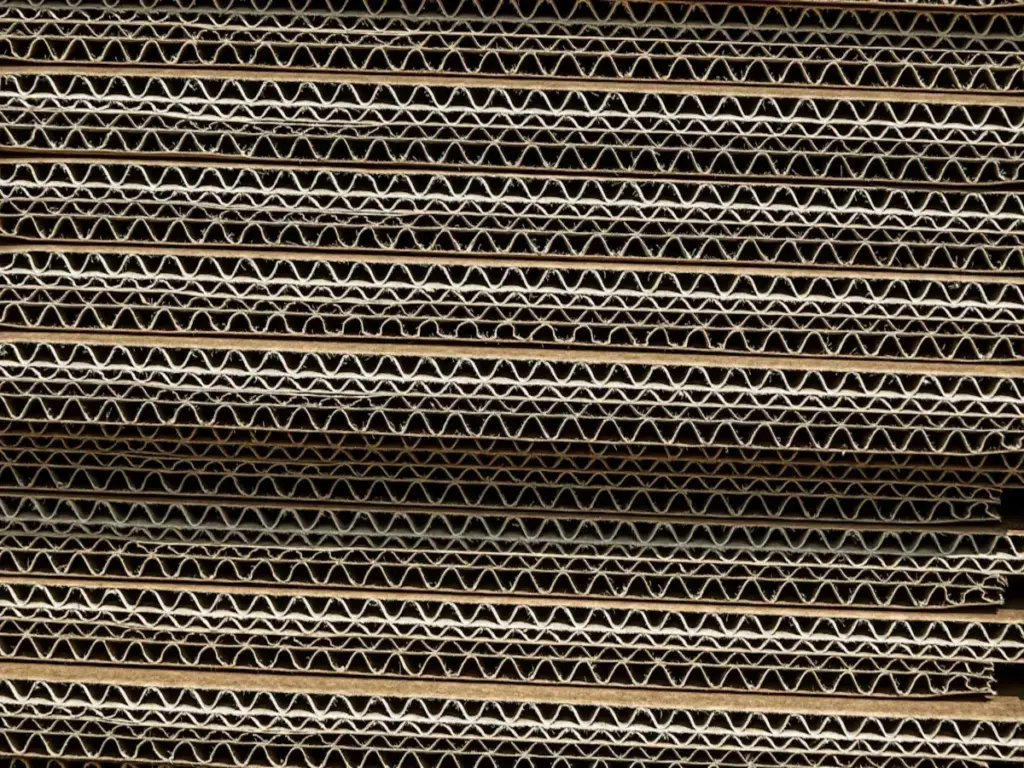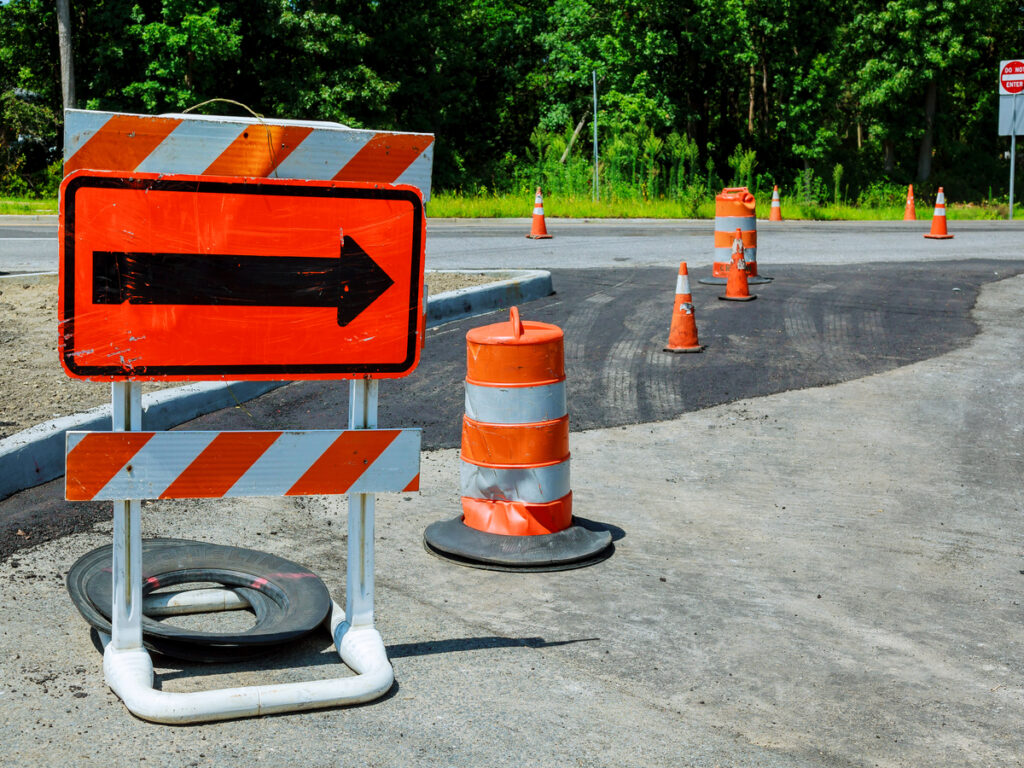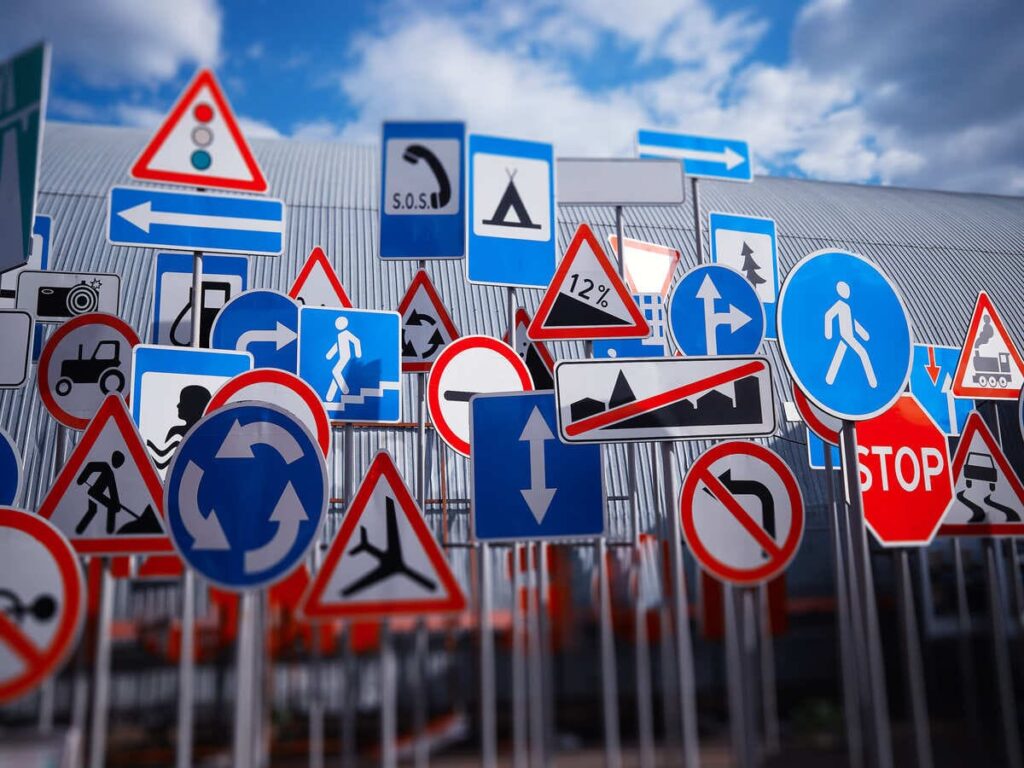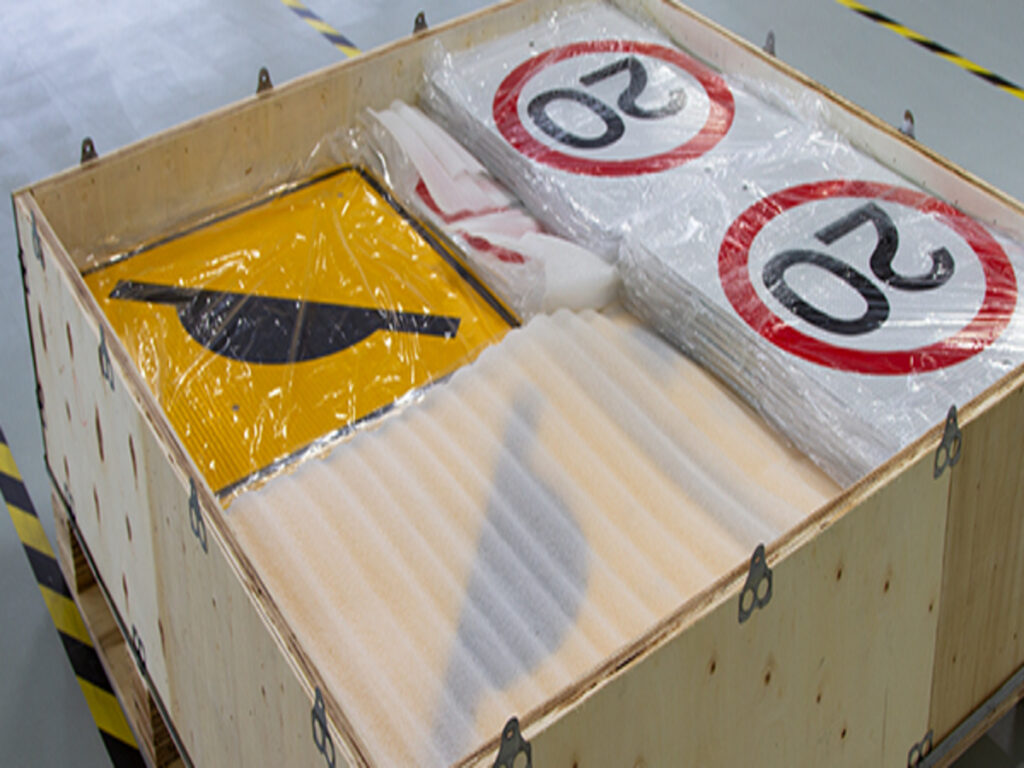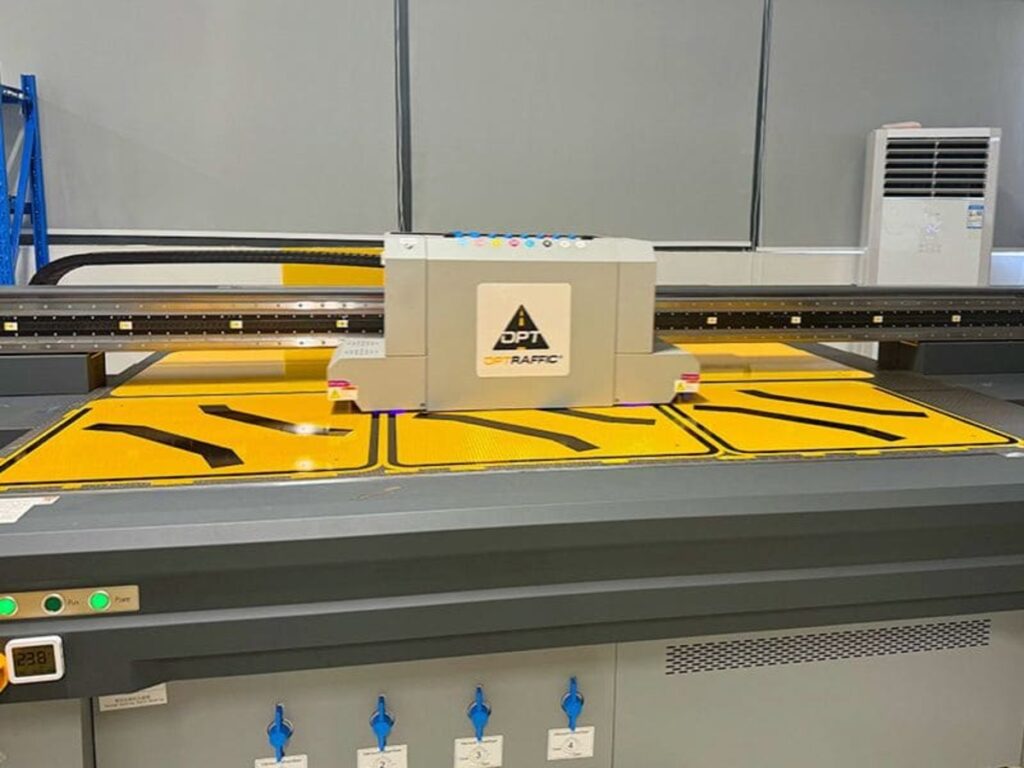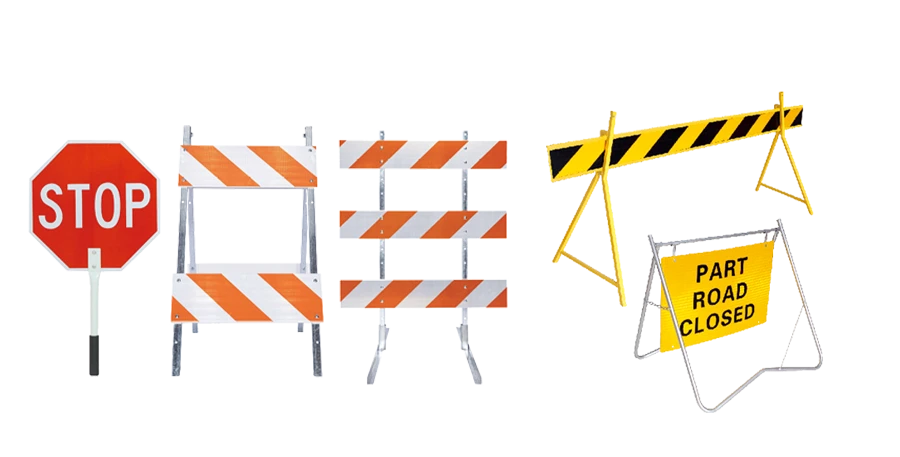
Las señales de tráfico reflectantes son muy importantes para mantener a las personas seguras en las carreteras australianas. Estas señales ayudan a los conductores a ver información clave, incluso de noche o cuando hace mal tiempo. Las señales de tráfico en la construcción utilizan materiales especiales para que sean más fáciles de ver y para advertir a los conductores sobre los cambios que se avecinan.. Los estudios demuestran que mejores señales de tráfico reflectantes y señales de tráfico de construcción ayudan a los conductores a notar las señales antes., reaccionar más rápidamente, y parar cuando lo necesiten.
En Optraffic, we are a leading sign manufacturer with a vast customer base, ofreciendo de alta calidad Señales de tráfico a la venta que cumplen con los estándares australianos. Our in-house production ensures the best quality control, and we are committed to providing durable and reliable signage solutions to keep roads safe.
Control de llave
- Reflective sheeting on traffic signs helps drivers see signs at night. También ayuda en mal tiempo. Esto hace que las carreteras sean más seguras para todos.
- Australia uses strict rules like AS/NZS 1906 y como 1742. These rules make sure traffic signs are bright and last long. They also make signs easy to read.
- There are three classes of reflective sheeting. Clase 1 is good for quiet streets. Clase 2 is used in places with some traffic. Clase 3 is best for busy highways and dangerous areas.
- Traffic signs need to be cleaned and checked often. This keeps them bright and working well. It helps drivers see warnings and stay safe.
- Picking the right reflective sheeting is important. Following the care rules helps councils keep roads safe. It also makes signs last longer.
Reflective Traffic Signs and Standards
Como/nzs 1906 Descripción general
Como/nzs 1906 is the rule for reflective traffic signs in Australia and New Zealand. This rule says how materials should work so drivers see signs well, Incluso por la noche o en mal tiempo. It talks about reflectivity, durabilidad, y color. These rules help keep people safe by making sure signs stay easy to see for a long time. Research shows dirt and damage make reflective traffic signs work less well. Por ejemplo, studies using mobile LiDAR and photolog technology found dirt, sign height, and air pollution change how much light signs reflect. Cleaning and checking signs often helps them follow the rules and keeps roads safer.
COMO 1742 y MUTCD
COMO 1742 gives the rules for using reflective traffic signs on Australian roads. It tells where to put signs, what shapes and colours to use, and how to make them simple to read. El Manual de dispositivos de control de tráfico uniformes (Muescato) works with AS 1742. It explains how to use signs, señales, and markings so everyone gets clear messages. Studies show that damaged signs do not reflect light as well, which is important at night. If signs do not follow these rules, drivers might miss warnings and accidents can happen. Checking and fixing signs often helps keep roads safe and makes sure rules are followed.
To learn more about road sign standards and how they differ across regions, Mira nuestro blog en Comprensión de los estándares de signo de seguridad vial: Muescato (EE.UU), COMO 1742 (Australia), y la convención de Viena (Europa).
International Alignment
Australia matches many of its rules with international guidelines to keep up with new technology in signs and road safety. Standards Australia works with groups like ISO and IEC to make and update rules. About one-third of Australian rules are the same as international ones, but some, like building and health, have their own local rules. Por aquí, Australia can use new ideas and best ways from other countries. The chart below shows how Australia’s rules compare with international rules.

Nota: Matching global rules helps Australia make roads safer and lets reflective traffic signs use the newest technology.
Classes of Reflective Sheeting

Reflective sheeting helps drivers see road signs in bad weather or at night. En Australia, there are three main classes of reflective sheeting. Each class has its own features and uses. Picking the right class keeps roads safe and makes sure signs follow the rules.
Clase 1 Características
Clase 1 láminas reflectantes is used most for construction traffic signs where traffic is not too heavy. This sheeting has a sticky back that workers can peel off and stick onto clean, smooth surfaces. No heat is needed to put it on. Clase 1 works well in normal temperatures and is easy to use.
| Clase | Adhesive Type and Application Method | Tolerancia a la temperatura | Características clave |
|---|---|---|---|
| 1 | Pressure-sensitive, self-adhesive; peel and stick | Standard temperatures; no heat needed | Most common; simple installation on smooth, clean surfaces |
Clase 1 reflective sheeting gives basic reflectivity. It is good for signs on city streets, neighbourhood roads, and places with less danger. People like this class because it is cheap and simple to use. But it might not be bright enough for busy highways or dark places.
Clase 2 Características
Clase 2 láminas reflectantes is brighter than Class 1. It needs heat to stick, so workers use a heat press to put it on. This makes the bond strong and long-lasting. Clase 2 often uses microprismatic technology, which makes signs shine more in low light.
| Aspecto | Supporting Details |
|---|---|
| Tecnología reflexiva | Uses enhanced glass bead and microprismatic technology with a protective transparent shell, increasing reflectivity compared to Class 1. |
| Métricas de rendimiento | Minimum reflectivity of 180 CD/LX/m², about three times that of Class 1, improving visibility in low light and adverse weather. |
| Durabilidad | Warranty of 10 a 12 años; resistant to UV rays, humedad, y cambios de temperatura, ensuring long-term clarity and brightness. |
| Aplicaciones | Commonly used for speed limit, advertencia, direccional, and regulatory signs in urban, rural, and highway environments. |
| Cumplimiento regulatorio | Meets standards such as BS EN 128991:2007, ensuring operational reliability and safety compliance. |
| Rentabilidad | Higher initial cost than Class 1 but balanced by longer lifespan and improved safety performance, making it cost-effective for medium-speed roads. |
Clase 2 reflective sheeting is best for signs on smaller highways, city corners, and places with some traffic. It helps drivers see signs better at night or when it rains or is foggy. Muchos consejos usan la clase 2 for warning and rule signs where extra safety is needed.
Clase 3 Características
Clase 3 láminas reflectantes is the brightest type. It has a sticky back that can be moved around before pressing it down. No heat or chemicals are needed. This makes it easy to adjust during installation.
| Clase | Adhesive Type and Application Method | Tolerancia a la temperatura | Características clave |
|---|---|---|---|
| 3 | Bajo tapa, adhesivo sensible a la presión reposicionable | Repositionable up to 100°F without damage | No heat or solvent needed; allows repositioning on smooth surfaces |
Clase 3 reflective sheeting is best for signs on highways, big crossroads, and places with lots of danger. It shines very brightly in the dark or when it rains. Los conductores pueden ver estas señales desde lejos., que ayuda a detener los accidentes. This class is picked for busy roads or where safety matters most.
To understand why investing in Class 3 reflective sheeting is a smart choice, Lea nuestro blog: El costo de la seguridad: Por qué invertir en clase 3 Las láminas reflectantes valen la pena para las autoridades de la carretera australiana.
Choosing the Right Class
Choosing the right reflective sheeting depends on many things. Each road and place needs careful thought. Here are some points to help choose:
- Retroreflectividad: This means how well the sheeting sends light back to drivers. Microprismatic sheeting gives a bright, narrow beam for seeing far away. Glass bead sheeting spreads light out for seeing up close.
- Light dispersion: Some types work better for signs seen from far away, others for signs seen up close.
- Brillo: Very bright sheeting is important for signs on fast or dangerous roads.
- Durabilidad: Strong sheeting lasts longer and does not need to be replaced often, Incluso en mal tiempo.
- Adhesion and flexibility: The sticky part and how bendy it is help it stick to different surfaces.
- Surface type: Liso, clean surfaces help the sheeting stick better and shine more.
- Regulaciones: Rules like AS/NZS 1906, COMO 1742, and MUTCD say how to use reflective sheeting for signs.
- Product data: Things like thickness, outdoor life, and if it can be printed on help match the sheeting to the job.
Consejo: Always pick the class of reflective sheeting based on how busy the road is, how much light there is, and what kind of sign is needed. For busy highways or dark places, Clase 3 is usually safest. For quiet streets or short-term signs, Clase 1 o clase 2 podría ser suficiente.
Picking the right class makes sure signs stay easy to see, cumplir con las reglas de seguridad, and help keep everyone safe on the road.
Performance and Increasing Road Safety
Retroreflectividad
Retroreflectividad is how well a sign sends car headlights back to drivers. This helps people see signs at night or when the weather is bad. Retroreflective sheeting uses new technology to make main road signs brighter. These signs can be seen from far away. Tests like ASTM E1710 check how much light the signs reflect. Limpio, dry signs shine best, but dirt, agua, and age can make them up to 28% less bright. Machine learning now helps guess how reflectivity changes over time. This helps councils know when to clean or fix signs. Checking and cleaning signs often keeps them bright and easy to see at night. Esto ayuda a que las carreteras sean más seguras para todos.
Durability and Weather
Durability means how long a sign stays bright and easy to read. Bad weather like hail, viento, and lightning can harm signs. Forensic weather reports show when storms happen and if signs get damaged. These reports help councils and insurers decide if signs need to be replaced. Good retroreflective sheeting does not fade, grieta, o pelar, even after years of sun or rain. Strong reflectivity means signs stay safe and easy to see in all weather. Councils trust these materials to keep roads safe and stop signs needing to be changed too often.
Impacto de visibilidad
La visibilidad es muy importante para la seguridad vial. Different reflective sheeting classes help people see signs better in different places. Studies look at how well people spot signs with different materials:
| Estudiar (Año) | Sheeting/Class | Visibility Distance/Detection | Result/Statistic |
|---|---|---|---|
| Allen (1970) | Reflectorised jacket | Visibility distance | 234m vs 118m (higher with reflectorised) |
| Cole (1984) | White vs black discs | Detection frequency | 46% VS 35% (white higher) |
| Owens (2007) | Retroreflective slash | Recognition frequency | Ambos 97% |
Fluorescent and retroreflective materials help drivers see and know signs faster, Especialmente por la noche. Brighter signs mean drivers react quicker and miss fewer warnings. Reports show that better visibility lowers crashes, especially at busy crossroads. Watching things like deaths, lesiones, and crash numbers helps councils see if new materials work. Local data and regular checks help councils keep roads safe for everyone.
Compliance and Safety Requirements
Cuerpos reguladores
Many groups watch over construction traffic signs in Australia. State and territory road authorities, como Transporte para NSW y Vicroters, make sure rules are followed. These groups check that construction traffic signs are easy to see and last a long time. Standards Australia writes and updates the main rules, such as AS/NZS 1906 y como 1742. Local councils also check construction traffic signs on their roads. Safety inspectors help by checking signs and making sure rules are followed. Managers who care about safety help everyone follow the rules better.
Doing regular checks and keeping good records helps find problems and shows where things can get better.
- Audit reports check if rules are followed and show what needs fixing.
- Keeping clear records and checking them often helps everyone follow the rules.
- Training and teaching workers helps them know the rules and stay safe.
- Checking records often makes sure they are right and up to date.
- Using computers to keep records helps people see changes quickly and make good choices.
Certificación y prueba
Testing and certification show that construction traffic signs follow all the rules. Certification uses checks inside and outside the company. These checks look at quality systems and if rules are being followed. Inspections use looking, pruebas, and picking samples to find any problems. Testing checks if signs are safe, fuerte, y buena calidad. Outside groups give certificates when signs meet the rules. These groups must be checked to make sure they do a good job. The ISO process uses checks, capacitación, and looking for gaps to make sure rules are followed.
- Certification checks if quality systems and rules are followed.
- Looking at signs and testing them helps make sure they are good.
- Checking the groups that give certificates makes sure they are skilled.
Mantenimiento e inspección
Keeping construction traffic signs working well means checking and fixing them often. Councils and road authorities plan checks to find damage or fading. Records of fixing and checking must be correct and easy to find. Preventive maintenance means looking at signs often and fixing small problems before they get worse. How often signs are checked depends on what they are and how much they are used.
| Frecuencia de mantenimiento | Key Activities and Records |
|---|---|
| Semanalmente | Señales limpias; look for dirt or damage; check if they shine. |
| Mensual | Check how signs are held up; fix or change broken parts. |
| Anual | Get a professional to check signs and how well they shine. |
| Mantenimiento de registros | Keep digital records for rules, warranty, and tracking signs. |

Consejo: Keep construction traffic signs in a cool, dry place away from the sun. Handle signs gently so they do not get scratched or bent, which can make them less shiny and safe.
Checking signs often and storing them well helps them work better. This keeps them following the rules and helps keep roads safe.
Aplicaciones: Construction Traffic Signs and More

Reflective sheeting is very important for many signs in Australia. Construction traffic signs, reflective directional main road signage, regulador, advertencia, and guide signs all use it. These signs help drivers find their way and stay safe on every road. The type of reflective sheeting depends on where the sign goes and how risky the area is.
Urban and Rural Use
Cities have busy roads and lots of signs. Construction traffic signs in cities use reflective directional main road signage to help drivers with detours and roadworks. These signs need to be easy to see with all the city lights and noise. En el campo, roads are often dark and quiet. Construction traffic signs and reflective directional main road signage help drivers spot changes or dangers ahead. Studies in Connecticut and South Carolina showed that brighter Señales de parada meant fewer crashes, especially at quiet crossroads. Upgrading to better reflective sheeting does not cost much but makes roads safer. Both city and country councils use these signs to help drivers and keep roads safe.
Áreas de alto riesgo
Some places need more care to keep people safe. High-risk areas are highways, giros agudos, y zonas de construcción. Traffic signs with diamond-grade reflective directional main road signage are the easiest to see. These signs help drivers notice danger from far away, Incluso bajo lluvia o niebla. Traffic managers say that using the best reflective materials in these places helps drivers behave better and stops more accidents. Special coatings on the signs keep them bright and clear, even after storms or if someone tries to damage them.
Estudios de caso
Real-life stories show why construction traffic signs and reflective directional main road signage matter. One city changed old signs for new ones with high-intensity reflective materials at a busy crossing. Después de esto, drivers kept to speed limits more and there were fewer crashes. En el campo, construction traffic signs with better reflective directional main road signage helped drivers see detours at night, so they did not get lost. Makers now use eco-friendly materials and strong coatings, so signs last longer and are better for the planet. These changes in construction traffic signs and reflective directional main road signage help everyone stay safe and find their way.
Construction traffic signs use different types of reflective sheeting for many reasons. Clase 1, 2, y 3 materials help signs stay easy to see in all weather. Following AS/NZS 1906 y como 1742 makes sure construction traffic signs follow the rules and keeps people safe. People should look at construction traffic signs often and clean them when they get dirty. Here is a checklist to help:
- Pick the right class for construction traffic signs.
- Check construction traffic signs for any damage.
- Wash construction traffic signs often.
- Change construction traffic signs if they look faded.
- Look at AS/NZS 1906 y como 1742 for new updates.
Looking after reflective traffic signs often helps keep everyone safe on the road.
Preguntas frecuentes
What is the main purpose of reflective sheeting on traffic signs?
Reflective sheeting helps drivers see signs at night or when it is raining. It bounces car headlights back to the driver’s eyes. This makes roads safer and helps stop crashes.
How often should councils inspect and clean traffic signs?
Councils need to look at signs every week for dirt or damage. They should do bigger checks each month to find more problems. Cada año, experts check signs to make sure they are bright and safe.
Cleaning signs often keeps them easy to see and helps them last longer.
Which class of reflective sheeting suits highways best?
Clase 3 reflective sheeting is best for highways. It is the brightest and easiest to see. Los conductores pueden detectar estos signos desde muy lejos, Incluso bajo lluvia o niebla.
Do Australian standards match international rules for traffic signs?
Australian standards are similar to many international rules. This lets Australia use new technology and good ideas for road safety.
| Estándar | Alineación |
|---|---|
| Como/nzs 1906 | Matches ISO |
| COMO 1742 | Matches MUTCD |
Can damaged reflective sheeting affect road safety?
Sí, if the sheeting is dirty or broken, it does not shine as much. Drivers might not see important warnings. Councils must fix or change broken signs quickly to keep roads safe.


